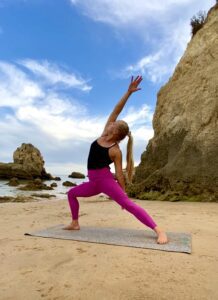Feeling stuck and inflexible in a yoga posture may be more than just tight hamstrings; it could be some old feelings holding you back. Unexpressed emotions become stored and held in the body and, over time, create physical tightness, stress, tension, and sometimes pain. Yoga is the perfect tool to release emotional tension in the body and to experience the healing that comes with this release. There are many tools that we can use within a yoga practice to uncover deeply stored emotions, bring them to the surface, and let them completely release from the body.
But why do we feel emotional during or after yoga?
Our emotional tensions and traumas are often woven into physical tension and pain. During yoga practices, we begin to unravel muscular tension and this process can also release the associated emotions bound in our muscles. Our yoga practice strengthens our physical, mental and emotional bodies and increases our capacity to process difficult emotions and past traumas. As our container strengthens our emotions feel safe to be released and expressed.
The slow deep pranayama breathing in yoga allows us to feel and pay attention to the subtle energies inside us. As this breathwork increases awareness and receptiveness of the subtle body we have an increased awareness of our emotional energies. Pranayama encourages the unblocking of our nadis or energy channels and this increases the ability for our emotions to flow as well.
The deep inner focus we cultivate in yoga will naturally allow you to become aware of forgotten or subconscious emotions. As the light of our focus and awareness shines brighter the more we are able to see inside of our shadowy selves.

Five Yoga Tools for Emotional Release
1. Pratyahara: inward focus
Pratyahara is a deep inward focus, rooted in the sensations of the breath and the body. As we bring our awareness inside the body, we can feel things that lie under the surface of ordinary awareness. When holding a yoga posture, keep the mind focused on where you feel and experience sensations. Explore where the sensations start, stop, and travel to, and pay close attention to any emotional feelings that arise from these physical sensations. When emotional feelings emerge keep your focus on the sensation of the feeling—and not the mind’s thoughts, reactions or memories—to encourage these emotions to be drawn out and fully released.
2. Pranayama: yogic breathing
There are several yoga breathing techniques that can encourage emotions to be stimulated, brought to the surface, and released. Dirga pranayama brings energy and awareness to the chest, belly, and hips and allows emotions to be released from deep within the body. Kapalabhati strongly stimulates and moves emotions that lay near the surface of the body, bringing them up and out. Breathing through the mouth invokes the emotional body and is highly effective in expressing and releasing emotions that have been brought to the surface, especially sadness and grief. Hara breathing (exhaling with a “Haaa” out of the mouth) helps release anger and frustration.
3. Vocalize: make sounds
Making sounds while holding a yoga posture opens the throat chakra and can allow tension and emotions to release from the body. Letting out a loud sigh eases frustration; humming releases joy; groaning softens fear; howling unbinds sadness. When emotions become activated and start to rise to the surface, vocalizing is especially important to completely release them out of the body.
4. Asana: backbends and hip openers
The hips, shoulders, chest, and throat are the primary places where emotional tension resides in our bodies. Make note of these places during asana practice or do a body scan at the start of your practice, looking for tension or tightness in these areas. Once you are aware of where emotional tension is held in your body you can focus on the yoga poses that target that area.
5. Intensity: holding the postures
When you find the posture that opens areas of tension and invokes emotional sensations, it is important to hold the posture to your edge. Just going to the physical or mental edge in any posture hold can activate an emotional release, but it will be especially cathartic in the postures where you hold tension. While holding these poses, utilize all of the above techniques for the strongest effect and most complete emotional release. Longer hold times can be facilitated with the use of props and restorative postures or physically supported by a yoga teacher or yoga therapist.
8 Yoga Poses to Release Emotions
While an emotional release can happen in any yoga pose, there are several poses that are most likely to generate an emotional response.
• Pigeon Pose (Pada Rajakapotasana)
• Happy Baby Pose (Ananda Balasana)
• Fire Log Pose (Agnistambhasana)
• Downward Facing Frog (Adho Mukha Mandukasana)
• Extended Dog Pose (Utthita Svanasana)
• Fish Pose (Matsyasana)
• Wheel Pose (Urdhva Dhanurasana)
• Chair Twist (Parivrtta Utkatasana)




